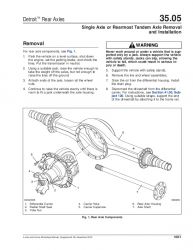Sterling Trucks L-Line and A-Line Factory Service & Shop Manual
Catalog:
Model:
Complete workshop repair service manual with electrical wiring diagrams for Sterling Trucks L-Line and A-Line. It's the same service manual used by dealers that guaranteed to be fully functional and intact without any missing page.
This Sterling Trucks L-Line and A-Line (A9500, A9522, L7500, L7501, L8500, L8511, L8513, L9500, L9501, L9511, L9513, L9522) service & repair manual (including maintenance, overhaul, disassembling & assembling, adjustment, tune-up, operation, inspecting, diagnostic & troubleshooting…) is divided into different sections. Each section covers a specific component or system with detailed illustrations. A table of contents is placed at the beginning of each section. Pages are easily found by category, and each page is expandable for great detail. The printer-ready PDF documents work like a charm on all kinds of devices.
“Sterling Trucks L-Line and A-Line.pdf”
Sterling Trucks L-Line and A-Line Service Manual; 2,894 pages; STI-384, S26 (11/10P)
Models: A9500, A9522, L7500, L7501, L8500, L8511, L8513, L9500, L9501, L9511, L9513, L9522
EXCERPT:
Power Steering Gear, TRW THP60 46.07
Poppet Component Replacement
Replacement
1. Remove the rack piston from the steering gear. For instructions, see Subject 150.
2. Place the rack piston in a soft-jawed vise.
3. Place special tool, J36452-A, over the seat of the poppet seat and sleeve assembly and engage the special tool in the slots of the threaded sleeve. Hit the end of the tool firmly four or five times with a two-pound sledge hammer to loosen the Loctite®.
4. Place a ratchet on the special tool and remove the seat and sleeve assembly from the rack piston. If the ratchet does not turn easily, strike the special tool again with a hammer. If the engaging tangs won’t stay in place while torquing, it may be necessary to hold the tool in place with an arbor press while applying loosening torque.
5. Discard the poppet seat and sleeve assembly. See Fig. 1.
…
Electronic Leak Detection
NOTE: Do not try to use a leak tester right after connecting or disconnecting service hoses. Traces of refrigerant at the fittings can falsely signal a leak. Always verify a leak by blowing shop air in to the area of the suspected leak and checking the area again.
When checking for leaks, move the probe all the way around the fitting or suspected leak.
Freightliner recommends using only certain makes of the heated diode and infrared (IR) types of electronic leak detectors.
Recommended electronic heated diode type leak detectors are available from their manufacturers. See Table 3.
Another type of detector, the corona discharge type, is specifically not recommended.
Use the following procedures to locate refrigerant system refrigerant gas leaks using an electronic leak detector.
1. Operate the electronic leak detector in accordance with the manufacturer’s instructions.
2. Leak test with the engine turned off.
3. Charge the air conditioning system with sufficient refrigerant to indicate a gauge pressure of at least 50 psi (345 kPa) with the system not operating. Typically, one-half pound (0.22 kg) of refrigerant is sufficient to create 50 psi (345 kPa) of pressure. It may not be possible to produce this amount of pressure and measure leakage if the ambient temperature is less than 59°F (15°C).
…





